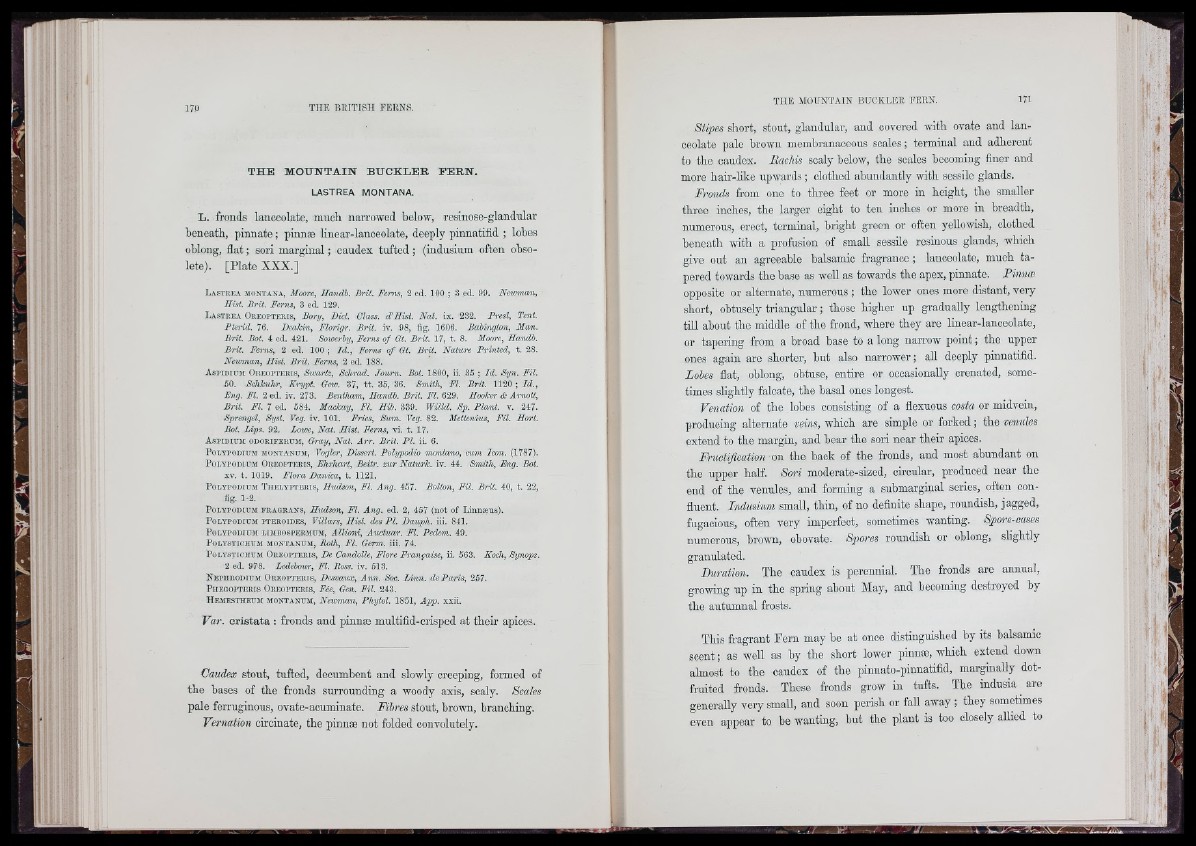
I
THE MOUNTAIN BUCKLER PERN.
LASTREA MONTANA.
L. fronds lanceolate, much narrowed below, resinose-glandular
beneatb, pinnate ; pinnæ linear-lanoeolate, deeply pinnatifid ; lobes
oblong, flat ; sori marginal ; caudex tufted ; (indusium often obsolete).
[Plate XXX.]
L a s t k e a MONTANA, Moorc, Hmidh. Brit. Ferns, 2 ed. 100 ; 3 ed. 99. Newnimi,
Hist. Brit. Perns, 3 ed. 129.
L a s t k e a O e e o p t e r i s , Bory, Diet. Glass. PHist. Nat. ix . 232. Presl, Tent.
Pterid. 76. Deakin, Flmigr. B rit. iv. 98, lig. 1606. BaUngton, Man.
Brit. Bot. i cd. 421. Sowerby, Ferns o f Ot. Brit. 17, t. 8. Moore, Handb.
Brit. Ferns, 2 ed. 100 ; Id ., Ferns o f Gt. Brit. Nature Printed, t . 28.
Newman, Hist. B rit. Ferns, 2 ed. 188.
A s p id iu m O r e o p t e r i s , Swarh, Schrad. Journ. Bot. 1800, ii. 35 ; Id. Syn. Fil.
60. Schkuhr, Krypt. Gew. 37, t t . 35, 36. Smith, FI. Brit. 1120 ; Id .,
Eng. FI. 2 ed. iv. 273. Bentham, Handb. Brit. FI. 629. Hooker & Amott,
Brit. FI. 7 ed. 584. Maekay, FI. Hib. 339. Willd. Sp. Plant, v. 247.
Sprengel, Syst. Veg. iv. 101. Fries, Sum. Veg. 82. Mettenius, Fil. Hort.
Bot. lAps. 92. Lawe, Nat. Hist. Ferns, vi. t . 17.
A sp id ium o d o e ie e k um , Gray, N a t. A r r . Brit. PI. ii. 6.
P olypodium montanum, Vogler, Dissert. Polypodio montano, cum Icon. (1787).
P olypodium Or eo pt er is , Ehrhart, Beitr. zu r N a tu rk . iv. 44. Smith, Eng. Bot.
XV. t . 1019, Flora Danica, t . 1121.
P o l y p o d i u m T h e l y p t e r i s , Hudson, FI. Ang. 457. Bolton, Fil. B rit. 40, t . 22,
fig. 1-2.
P olypodium f r a g e .ans, Hudson, FI. Ang. ed. 2, 457 (not of Linnæus).
P olypodium it e r o id e s , Villars, Hist, des PI. Dauph. iii. 841.
P olypodium limbospermum, Allioni, Aucluar. FI. Pedem. 49.
P o l y s t i c h u m m o n t a n u m , Roth, FI. Germ. ii i. 74.
P olystichum Oe e o it e k is , De Candolle, Flore Française, ii. 563. Koeh, Synops.
2 ed. 978. Ledebour, FI. Ross. iv. 513.
N eph r o d ium Or eo p t er is , Desvaux, An n . Soc. L in n , de Paris, 257.
P h eg opt er is Or eo pt er is , Fée, Gen. Fil. 243.
H emesth eum m o nta num, Newman, Phytol. 1861, App. x x ii.
Var. cristata ; fronds and pinnæ multifid-crisped at their apices.
Caudhx stout, tufted, decumbent and slowly creeping, formed of
the bases of the fronds surrounding a woody axis, scaly. Scales
pale ferruginous, ovate-acuminate. Fibres stout, brown, branching.
Vernation circinate, the pinnæ not folded oonvolutely.
Stipes short, stout, glandular, and covered with ovate and lanceolate
palo brown mombranacoous scales ; terminal and adherent
to the caudox. Rachis scaly below, the scales becoming finer and
more hair-like upwards ; clothed abundantly with sessile glands.
Fronds from ono to throe feet or more in height, the smaller
three inches, the larger eight to ton inches or more in breadth,
numerous, erect, terminal, bright green or often yellowish, clothed
beneath with a profusion of small sessile resinous glands, which
give out an agreeable balsamic fragrance ; lanceolate, much ta pered
towards the base as well as towards the apex, pinnate. Pinnæ
opposite or alternate, numerous ; the lower ones more distant, very
short, obtusely triangular ; thoso higher up gradually lengthening
till about tho middle of the frond, where they are linear-lanoeolate,
or tapering from a broad base to a long narrow point ; the upper
ones again are shorter, but also narrower; all deeply pinnatifid.
Lobes flat, oblong, obtuse, entire or occasionally orenated, sometimes
slightly falcate, the basal ones longest.
Venation of the lobes consisting of a floxuons costa or midvein,
producing alternate veins, which are simple or forked ; the venules
extend to the margin, and boar the sori near their apices.
Fructification on the hack of the fronds, and most abundant on
the upper half. Sori moderate-sized, circular, produced near the
end of the venules, and forming a suhmarginal series, often confluent.
Indusium small, thin, of no definite shape, roundish, jagged,
fugacious, often very imperfect, sometimes wanting. Spore-eases
numerous, brown, obovate. Spores roundish or oblong, shghtly
granulated.
Duration. The caudex is perennial. The fronds are annual,
growing up in the spring about May, and becoming destroyed by
the autumnal frosts.
This fragrant Fern may he at once distinguished by its balsamic
scent ; as well as by the short lower pinnæ, which extend down
almost to the caudex of the pinnato-pinnatifid, marginally dot-
fruited fronds. These fronds grow in tufts. The mdusia ^ are
generally very small, and soon perish or fall away ; they sometimes
even appear to be wanting, hut the plant is too closely allied to
' '7 1
> 11
- i
' 4 ri
1, '